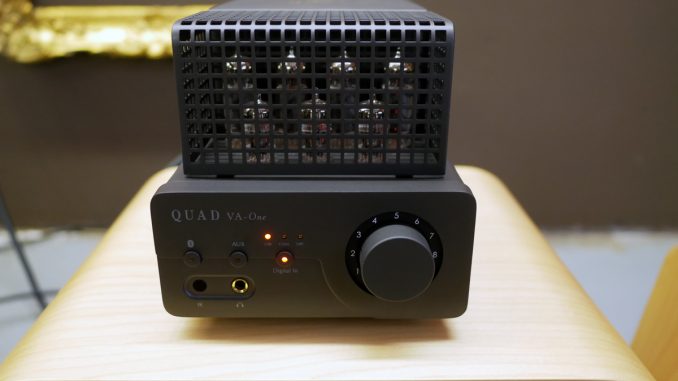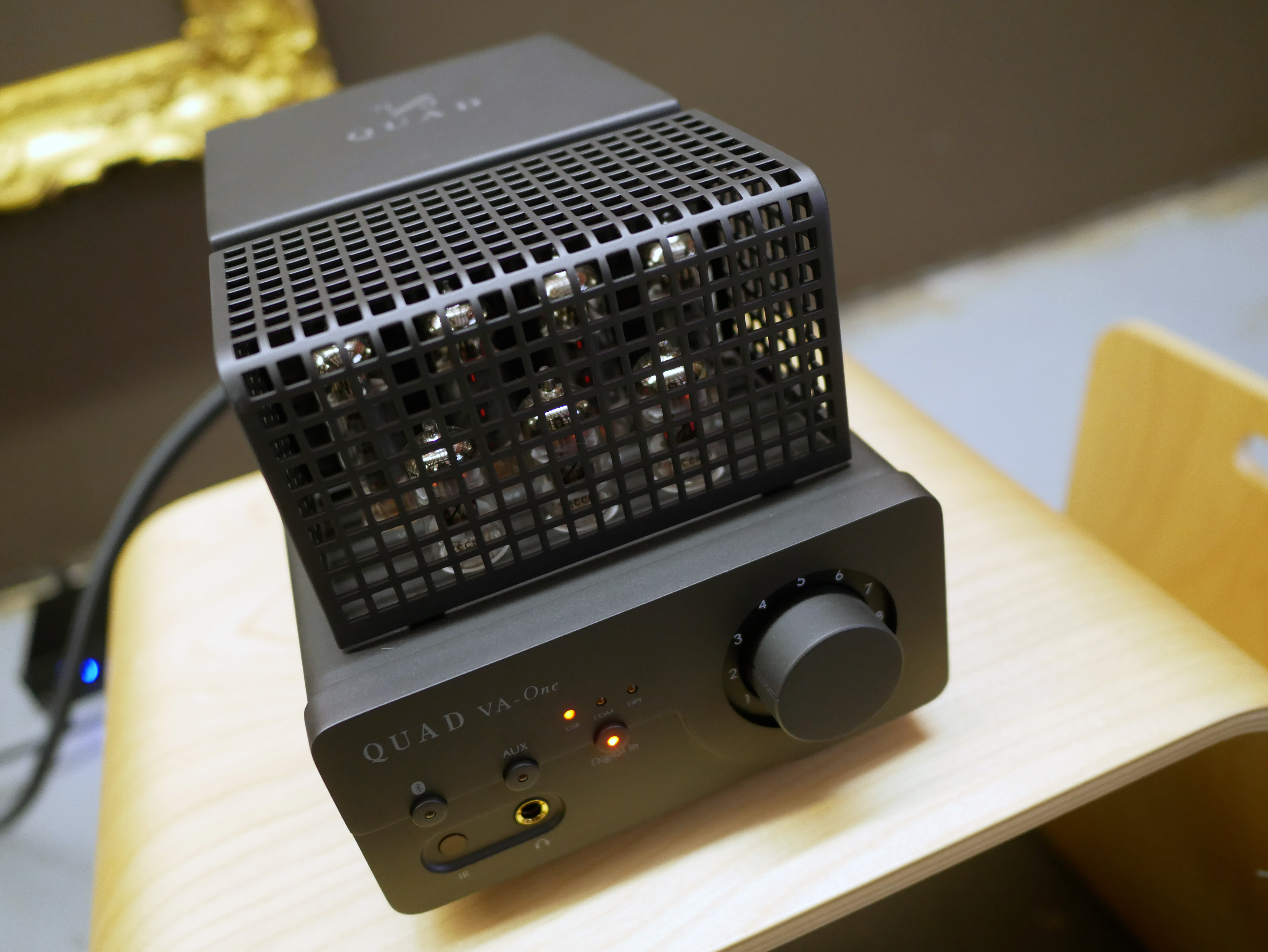
Listen here: I like tubes, I like integrated amplifiers, I like integrated amplifiers with DACs, I like Bluetooth, and I like well-made stuff. Seeing as the Quad VA-One is all of the above (and more), I like the Quad VA-One.

Both the preamplifer and amplifier sections of the VA-One utilize tubes: 2x ECC83 high-impedance triodes feeding an ECC82 twin triode driver and phase splitter stage for the preamp and a quad of EL84s in push/pull for the 12wpc (into 8 ohms) output stage. In my experience, there’s no such thing as a bad-sounding EL84-based amplifier but I haven’t heard them all, by a long shot. I still own and use the SAC Thailand Minute integrated amp (discontinued) I bought in 2005 for $350 (including shipping) which uses a pair of EL84’s for its output stage.

The VA-One is not your father’s EL-84-based integrated amplifier seeing as it includes a 24/192-capable DAC with all of the digital inputs you really need including USB, Toslink (for your TV’s audio output), Coax, and Bluetooth (aptX). There’s a single pair of RCA inputs (for your turntable or cassette deck) and a 3/4″ headphone jack up front for your ‘phones. Of course there are binding posts around back as well as an IEC inlet for your power cord of choice. I used the AudioQuest NRG-Y3 power cord ($109.95/1M) for this review because it makes thing sound better than a stock power cord. While we’re on the subject of cables, the AQ Forest USB cable ($35.95/0.75M) took the signal from my Sonore microRendu to the VA-One’s USB input and the AQ Type 4 speaker cables ($232.00/6′ pair) took the music to the speakers.
When you first power up the VA-One it automatically goes into standby mode, allowing things to heat up before making music while the volume level goes to 0. Once warmed, the front Bluetooth display lights up a brighter shade of orange compared the duller standby signal light and the little engine that could is ready to play.

The included remote is of the just what you need variety and it is 1,000,000 times better than every plastic remote ever made, especially the ones that come with all of those extra buttons that serve no purpose. < / I don’t like plastic remotes with extra buttons rant>
I spent some weeks listening to the Quad VA-One with two different speakers—the ELAC Debut 2.0 B5.2 ($249.98 /pair) and the Alta Audio Io ($3,495/pair) both bookshelf speakers which stood on sand-filled Target stands. Sensitivity wise, the ELAC’s are rated 86db @2.83v/1m while the Io’s are 87.5 dB / 2.83 Volts @ 1 Meter (manufacturer’s specs).

If you’ve read my system review of the ELAC Debut / PS Audio Sprout, you know I think the ELACs are a screaming bargain. Seeing as every review is a system review, I like the ELACs paired with the Quad VA-One even more. The Quad adds roughly $1,000 to the system cost so one would hope that this kind of scratch would get you better sounding music and in this case it does—the VA-One presents a more fully formed sound image coupled with a riper tonal palette as compared to the little Sprout. Music sounds rounder and richer which leads me deeper into the music, the direction we are all striving toward.
This combination was also capable of playing at respectable levels in-barn and I did not come close to maxing either one out. Of course, larger speakers and a more powerful amplifier, like my DeVore gibbon X and the Leben CS600 integrated amp, can rattle the barn’s bones and fill it and me up to the top, where this smaller and more wallet-friendly pairing leaves the rattling to my imagination. I would imagine that someone with a room, i.e. not a barn, would find the VA-One / ELAC system a fine match, and one not lacking in power.

That being said, more speaker gets you more of your music. The Alta Audio Io are a two-way design with a 2-inch ribbon tweeter and 7-inch midrange/woofer rated down to 42Hz by the manufacturer. The ELACs bottom out at 46Hz. Now 4Hz may not seem like much but you really have to ask yourself what the hell does Hz have to do with how music sounds? The Io’s present music with more flesh, blood, and bones as compared to the ELACs, making for a more moving musical experience. In terms of match-making, I’d say the VA-One / Io are most definitely a swipe-right kinda deal.
The VA-One coaxes a full-bodied, texturally and tonally rich sound from the Io’s that makes for a convincing and addicting musical presentation. Compared to the ELACs, there’s simply more there there. If you prefer, try picturing the musical image as a person where the ELAC’s person weighs a sprightly 130lbs while the Io’s person tips the scale at 190lbs. More weight is always a good thing when it comes to reproducing music as long as its fit.
If you’re thinking that the VA-One’s DAC may not give you everything you need because it tops out at 192kHz and does not do DSD or MQA, you have to ask yourself what the hell does kHz and bits have to do with music? Hint: focusing on bit rates and file formats gets you headed in the opposite direction from what we are all striving toward. My approach to digital music in terms of these matters is, in a word, lossless. With the Quad VA-One, you can get yourself a pair of speakers and a Tidal HiFi subscription ($19.99/mo) and immediately have access to a few million albums in lossless quality. And live happily ever after.

Speaking of more speaker, I moved my DeVore gibbon X back into their prime location, a task my back asks me not to do too often, and was greeted with more—there’s just no messing with physics and a larger speaker with more (larger) drivers moves more air. So there’s that. The VA-One managed to get a lot of the X’s goodness out into the room and I was somewhat surprised by how much.

Power was not an issue on the face of it, as the little engine that could drove the easy-to-drive DeVore’s—91.5dB/W/M, 8.5 Ohms (16 Ohms max, 7.3 Ohms min @ 26Hz)—to very respectable levels in-barn. There was also lots of music’s delicacy, color, and texture on display and I had no problem enjoying a wide range of music from Akira Rabelais to Led Zeppelin to Luigi Nono to Julia Holter to Flying Lotus, Giacinto Scelsi, Glenn Branca, Jenny Hval, Khun Narin, Giusto Pio, Fritz Hauser, Nico Muhly and more.

Compared to my Leben CS600 ($6,500) and totaldac d1-seven (17,450euros) the VA-One is more of a generalist with the DeVore’s where the costlier combo pulls out even more music from the source—it’s as if music reproduction comes with slider that dials in more or less depending on which way you slide it. With my combo, there is an exquisite amount of nuance, color, and control which allow the DeVore’s to fill the barn with a nearly all-enveloping performance. While the VA-One retains all of these traits, they are dialed back so that I don’t feel I’m getting the best of either player in this reproduction picture.

The thing about sliders when it comes to music reproduction is there’s no correct setting. This is one reason why we are so invested in our hifi’s—ideally, they represent the correct setting for us. Which is to say that for some listeners, the VA-One / DeVore X pairing may just hit all the right notes.

I moved the VA-One onto my Box rack so it could enjoy some vinyl too. While my phono setup accounts for the sound I heard as much as the VA-One’s RCA inputs I once again I fell into enjoyment-ville very easily. Spiritflesh‘s self-titled album was convincingly fleshly, for just one example. The same held for the headphone output into my AudioQuest NightOwls and while I don’t spend much time in private listening mode, this combination allows for such extended pleasures. To fill out the inputs I used picture, Bluetooth was as user-friendly as ever, if not the last word in sound quality. This is just fine by me since sometimes we need friendly more than quality.

I suppose the big question that wants an answer when it comes to gear reviews is—who is this thing for? The Quad VA-One is for people who own sensibly-designed speakers who want a big slice of the hifi pie in one lovely little machine. To my mind and interests, the VA-One has all of the inputs most people need to enjoy music whether it be streaming, wireless, analog, or the sound from your TV. You can listen in full party mode (through speakers) or privately (headphones) and all the while be delighted by music’s many moods, shapes, and colors.
Color me a fan.

